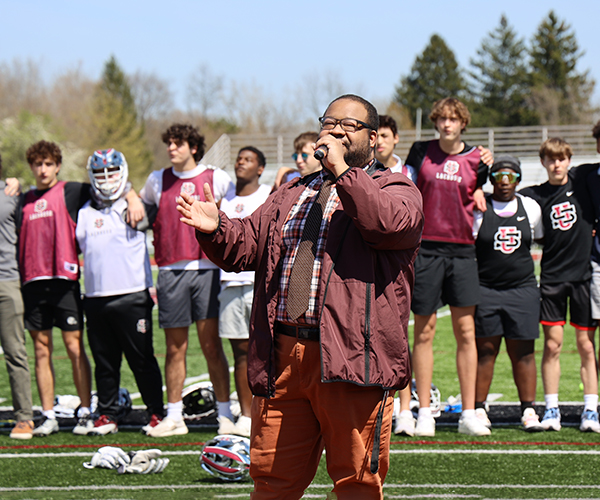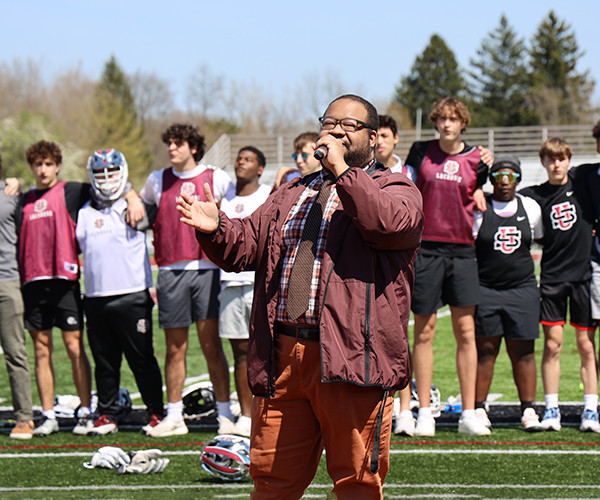It appeared that the lines had been drawn. The pessimists who coined phrases such as "brain drain" continued with their tales of woe about Cleveland's aging population and the flight of young intelligentsia. And then there were the optimists, positioned quietly on the sideline, plotting the next steps on how to entice bright, young college graduates to stay in town.
But with the summer season behind us, it appears that this time the good guys did not finish last, in fact, quite the opposite. This year, Cleveland not only enticed its own best and brightest but those from other cities to discover the opportunities that exist here.
Oscar Villarreal may not be a typical college student. A Mexican native, he was accepted at several Ivy League colleges, ultimately selecting the three/two program at Baldwin-Wallace College and Columbia University. Upon graduation, he will have earned a bachelor of arts in economics from Baldwin-Wallace and a bachelor of science from Columbia.
Today Villarreal doesn't want to talk about school. He wants to talk about his upcoming business trip to Mexico — a trip that may result in a more than $70 million contract for his summer employer, Tech-start. It seems that he initiated conversations with the Mexican company, has already visited to arrange subsequent meetings and is hoping to land the sizeable contract.
What's in it for him? "My employer is already talking with me about possibly paying for my tuition and having me work here full time," he says. "It's going to be a lot of work if I decide to do that. I'll have to give up playing varsity soccer, but it's something to consider."
In previous years, Villarreal had worked at Fortune-500 companies. This is his first stint with a smaller firm. He credits (i)Cleveland with the placement.
"I thank (i)Cleveland," he says. "I love the whole idea."
A highly selective program, (i)Cleveland is sponsored by the Greater Cleveland Partnership and operated by Cleveland Scholarship Programs Inc. A network of college students and area employers, (i)Cleveland is "focused on keeping the best and brightest minds in Northeast Ohio." In order to participate in the program, students must have earned a minimum 3.0 GPA, demonstrated leadership through extracurricular activities and work experience, and submitted short essays proving strong communication skills.
There is a social component to the program, too. "We believe that it's our responsibility to showcase Cleveland to these students," says Patrick Manfroni, (i)Cleveland coordinator. "It's so important to like where you work. So we send them to the neighborhoods as part of a scavenger hunt we organize. We sponsor an Interns Day at Jacobs Field."
"The people involved are very well selected," Villarreal says. "Every single person is so focused. Everything is about doing something."
Manfroni continues to be amazed by the outcome of the scavenger hunt. "We asked the students to meet with a community leader and get an autograph. One walked into National City Bank and had the president of the Ohio Region sign, another walked into City Hall and got a picture and signature with Mayor Jane Campbell."
But (i)Cleveland is not all fun and games. Participants attend summer workshops to learn from consultants about networking, manners, the impact of body posture, proper dining etiquette and more.
"Our goal is to stop the brain drain," Manfroni adds. "We have discovered that cities offering more internships have a higher probability of keeping people in their area." Of the approximately 60 students placed through the program, nearly 99 percent are from Northeast Ohio, but more than 72 percent attend college outside of the area.
According to Census Bureau reports from 1990 to 2000, Ohio lost more single, college-educated people during the 1990s than any other state except Pennsylvania, and more than 18,000 Ohioans who left the state between 1995 and 2000 held a college degree, were single and were age 25 to 39.
Manfroni emphasizes that summer internships often lead to full-time positions after graduation. The National Association of Colleges and Employers supports this hypothesis, citing conversion rates of interns to full-time employees at 38 percent and emphasizing that of new full-time hires, 59 percent have internship experience.
"The benefit of working here is that you get things done that would take longer or wouldn't get done elsewhere," adds Shirley Leonard, manager of public relations and marketing for the Cleveland Scholarship Program.
Summer intern Emily Grannis, a senior at Shaker Heights High School and editor-in-chief of the school's newspaper, approached Cleveland Scholarship Programs about creating an alumni newsletter. She not only designed and created the four-page publication on her own, but also is now continuing her efforts quarterly.
"I had a lot of fun and had a lot of support from the staff," she says.
John Goldston, a recent Hawken graduate who is attending the Wharton School of the University of Pennsylvania this fall, began working on the Malone Charity Golf Tournament as part of his senior project and ultimately worked in the program's accounting department.
"I didn't have experience in accounting or business. Now I have a feel for what it takes to do work. I believe I'll be a step ahead of the others who didn't get into business," Goldston says. "It's a great feeling to be involved with the workings of the organization."
No surprise then that companies such as Liggett Stashower and the Cleveland Clinic have introduced their own summer internship programs.
Liggett Stashower introduced its formalized program in 1999 (about the same time as (i)Cleveland was created). Eight to 12 college juniors and seniors are presented with the opportunity to work at the agency each year through a highly selective screening process. This summer, with more than 400 applications received, the agency hired a total of eight interns.
"Several interns have gotten jobs here," says Dana Meister, vice president, management supervisor in the advertising department. "We are looking for smart, motivated students who fit into our culture here, who are professional ("They need to know corporate etiquette") and are not intimidated. They should be the type of people who would introduce themselves and say, •How are you doing today?' and not sit by the sidelines."
Lisa Schwan, a senior at John Carroll University, fit the bill. A communications major and English minor, she worked in Liggett Stashower's public relations department. She also contributed to the L-S Intern Blog, offering advice to other college students and encouraging them to apply for internships, compile samples of their work and join school newspapers. While at the agency, she wrote press releases, made media calls and sent pitch letters. She also worked with the other interns on a special project, the creation of an agency yearbook, compiling work from previous years through now.
"This has given me hands-on experience," she says. "I have built relationships. It's been challenging."
At the Cleveland Clinic, the emphasis is not on creative writing but on science. "The program is designed to offer high school juniors and seniors the opportunity to do research at the Clinic," says Rosalind Strickland, senior director, office of civic education initiatives.
The nine-week program is designed to "strengthen the math and science curriculum and expand the science curriculum into the workplace," she adds.
But there is more to the program than that. There is inspiration and proof that summer internships work.
It all began 25 years ago. High school student Marc Gillinov served as an intern at the Cleveland Clinic working with Dr. Delos "Toby" Cosgrove, now the Clinic's CEO and president.
Today, Dr. Marc Gillinov is a surgeon in the department of thoracic and cardiovascular surgery. "He had his pick of any hospital, yet he chose to return here because of his experience," Strickland explains.
And then there's the five-year, $10 million commitment the Cleveland Clinic made to education and the Cleveland Municipal Schools under Cosgrove's leadership. Top that with his philosophy that "We begin building our work force for the next generation today, hoping that many will return."
This year, the Cleveland Clinic has included 41 students in its summer intern program. The goal for next year is to expand to 70.
Andrianna Stephens, a student at the Early College School, part of the Cleveland Public School System, learned about the program from Youth Opportunities Unlimited. Now entering her sophomore/junior year (the program graduates students in three years), she wants to become a doctor specializing in either endocrinology or psychiatry.
Working at South Pointe Hospital in Warrensville Heights, Stephens has been shadowing doctors and working on her project, "Effectiveness of Intensive Life Support Training." Like others in the program, she must present her project at the close of the internship. Her project involves working with Sim Man, a high-tech robotic simulator that breathes, has a pulse and maintains heart rhythm and blood pressure. She explains that the codes that are used in ERs are run on this educational tool often used by medical students."I would love to do this internship again," Stephens says. "I learned a lot. I knew nothing before and now I know medical terms."
Down the street at Case Western Reserve University, Bridget Essley, a molecular biology major and recent graduate of Colgate University, served her internship at Case Medical School. She worked in the Nutrition Department for Laura Nagy, Ph.D., conducting research aimed at understanding how alcohol consumption contributes to chronic diseases, including liver disease and diabetes.
Essley found her job through the Summer on the Cuyahoga program, the second generation of Bulldogs on the Cuyahoga, a program in which Yale students apply for summer internships in Northeast Ohio.
"The internship was encouraging," she says. "It was very different going to the school I went to and getting hands-on experience. A lot of the time, research may be discouraging when the outcome isn't exactly what you'd hoped. But, I learned so much and I liked what I was doing."
On Essley's first day on the job, she had an interview for her present position at the Cleveland Clinic where she is conducting anesthesiology research. "My boss at Case was so flexible. She let me end my summer internship a week early so that I could be trained by the person who left the position I filled at the Clinic."
The Summer on the Cuyahoga program, launched three years ago as Bulldogs on the Cuyahoga, started by using a model introduced in Louisville, Ky., by Yale alumni living there. Initially, 33 Yale students were involved with the Cleveland program, and ultimately Princeton, Case and Colgate jumped on board. This year, 65 students are participating.
Funded primarily by alumni who are group leaders in the private and public sector as well as corporations and Cleveland-based foundations, the program strongly promotes Cleveland through 46 social events and pairings with area alumni.
"Students are housed at Case. They have access to all student facilities and live together as a group," says program coordinator Marianne Crosley.
Close to 80 employees are posting jobs that are accessible to students on the Internet. Employers participate in the program at no cost, receiving and evaluating resumes that arrive via e-mail.
"Students return to campus as ambassadors to Cleveland," Crosley says. "Some come here feeling negative and leave with a totally new vision. They see that they can make a difference here • that they can make an impact. They can also reach their goals faster than New York or L.A."
Gwendolyn McDay, a recent Yale graduate from Vermont and environmental engineering major, participated in the program over the past two years. In her first year, she worked for ShoreBank Enterprise, a lending company for small businesses. This past summer she served as the program's on-site coordinator, staying with the students, coordinating events and ensuring that there was food at the events. She has landed a full-time position with Emerald Environment Inc., a Kent corporation with offices in Marietta and Akron. McDay will be working in its newly opened Cleveland office.
"The people here are invested in their community," she says. "They are looking for young people who long to establish themselves here. There are exciting programs happening here."
National Hiring Trends
The following are based on Experimental Education and Job Outlook Fall Preview surveys conducted by the National Association of Colleges and Employers (NACE).
• Nearly 80 percent of employers reported higher retention among their college hires who have internship or co-op experience — even if the college hire gained that experience with another company — versus those who had no such experience.
• About 76 percent said they see higher retention among those who have come directly from their own internship or co-op program compared with all other college hires.
• Nearly 98 percent of the employers reported that they pay their interns and nearly 95 percent said they pay their co-op students. (Undergraduates are paid an average of $15.46 and co-op students an average of $15.64).
• Overall, 66.5 percent of employers reported they expect to hire more new college graduates in 2005-06 than they hired in 2004-05.
• On a regional level, employers in the Northeast are projecting the biggest hiring gains: They expect to hire nearly 26 percent more new college graduates. The Midwest projected the lowest increase of 9.1 percent in college hiring.
— compiled by Arooj Ashraf
Sources
Job Outlook 2006 Fall Outlook Preview Survey: NACE conducted the survey between Aug. 8 and Aug. 19, 2005, by e-mailing 1,015 employers. Of that, 256 or 25.2 percent responded.
Experimental Education Survey: NACE conducted the survey between March 2 and April 15, 2005. Nationwide, 1,070 employers were contacted and 240 or 22.4 percent responded.



